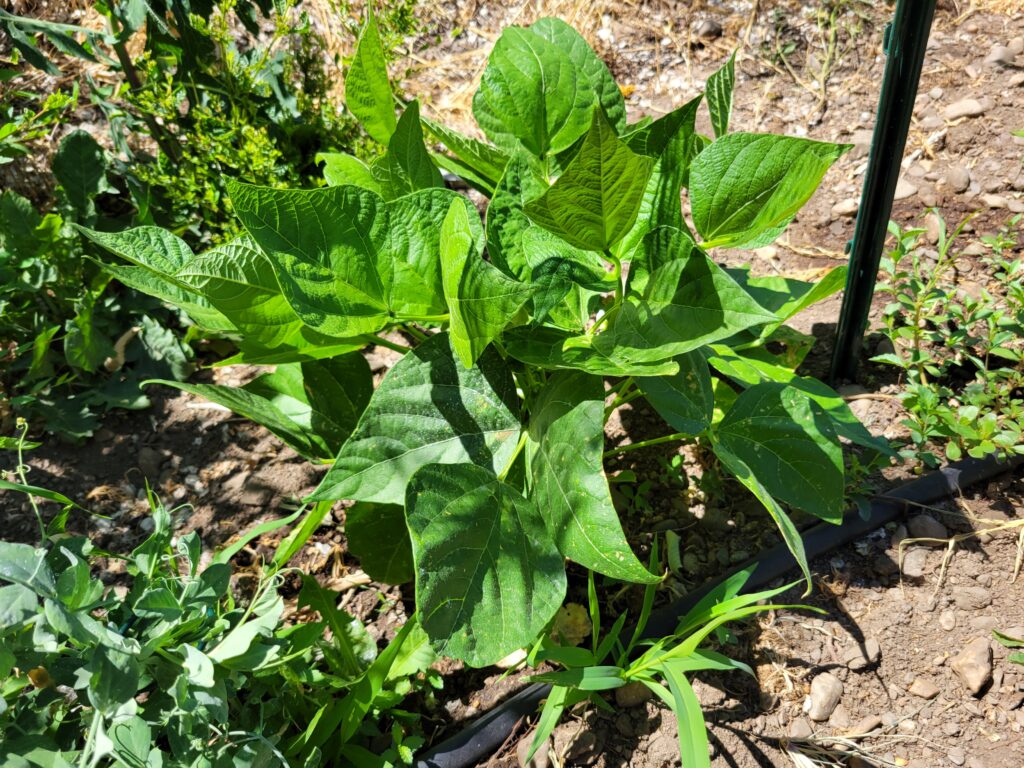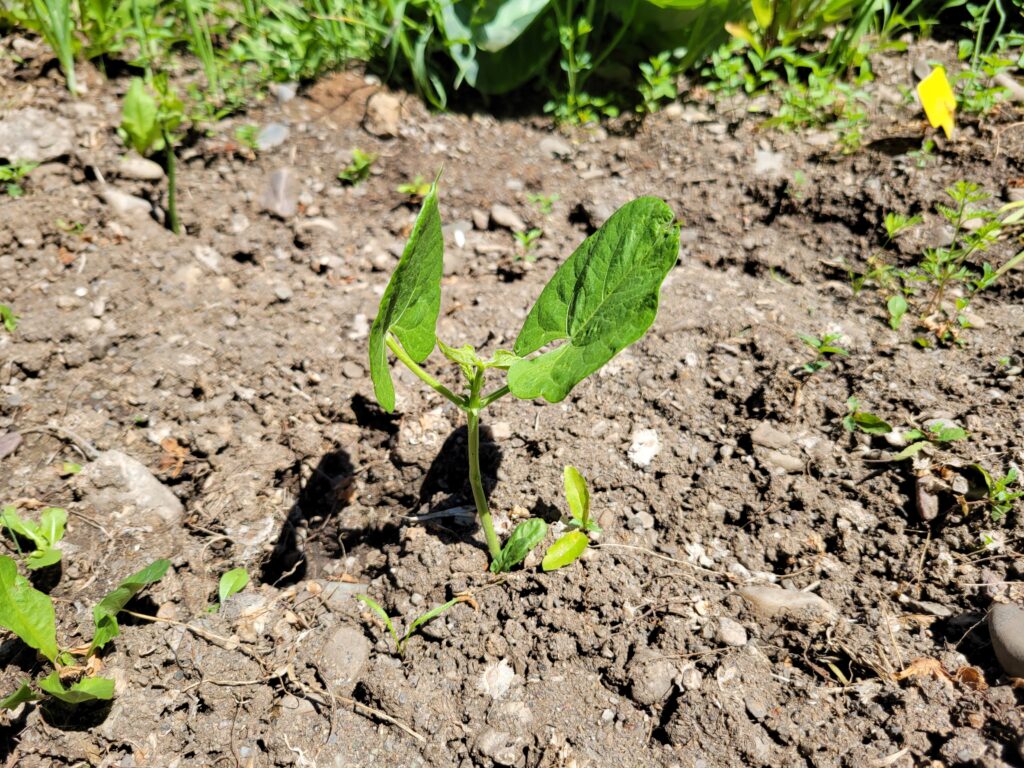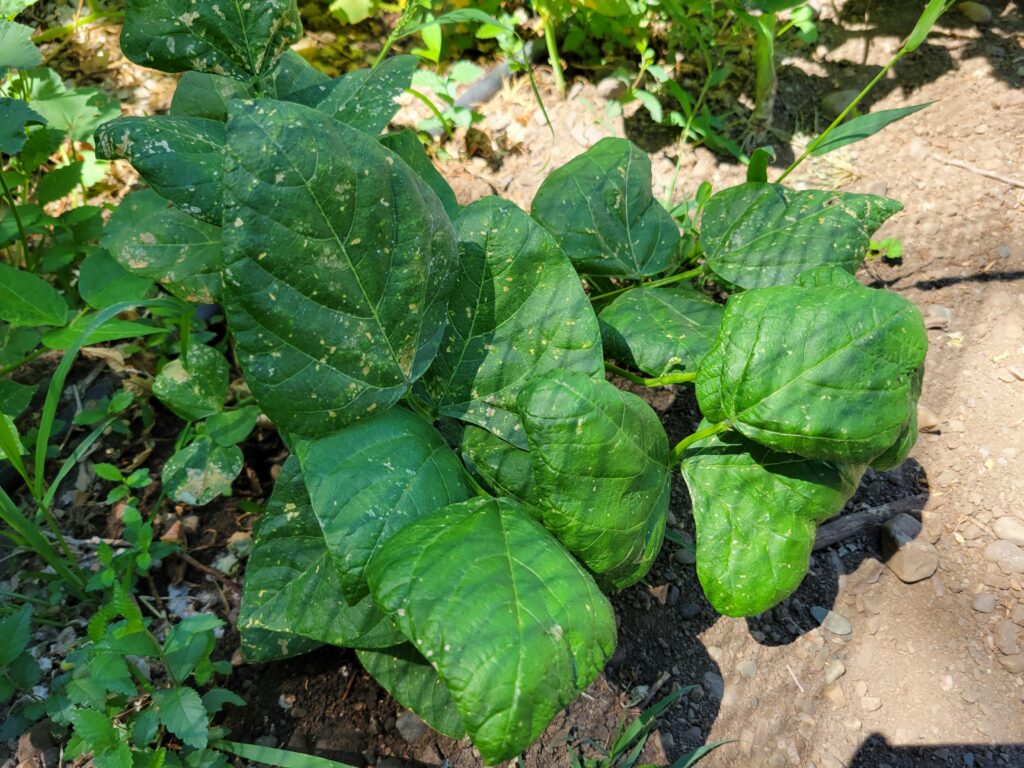There may be affiliate links in this post. If you buy something through one of these links, I’ll get a small commission at no extra cost to you. Please read full disclosure for more information.
If you soak beans before planting them, they will germinate faster and more easily. This means you can harvest your beans earlier!
This year is the first time I’ve grown beans in my garden, and I’m already in love with them. I love their hardiness and their large leaves. Especially when it seems like everything else has daintier and smaller leaves. So the pinto and kidney bean plants are really drawing my attention! They are so tall and bold.
Beans are a great addition to any vegetable garden, and some of them don’t need to be cared for all the time. After all, I do love it when you can set and forget.
Green beans are a beloved vegetable grown in home gardens across the country. Their versatility makes them an essential component of many summer meals. As a legume they fix nitrogen into the soil benefiting other crops grown nearby. When sowing green beans, a common question is whether soaking them first improves germination rates and plant health. There are pros and cons to pre-soaking that every gardener should consider.
Why Soak Seeds?
Soaking seeds before sowing them helps speed up the germination process. It mimics what occurs in nature when seeds experience moisture through rain snowmelt and humidity. The outer seed coat absorbs water and expands signaling to the embryo inside that it’s time to sprout. This kickstarts the process so the seedling can emerge sooner.
Soaking is especially beneficial for seeds with hard outer coatings. As the coating softens, it weakens and splits open more easily for the radical and shoots to break through when the embryo begins growing. The stored energy in the seed isn’t wasted trying to break through a tough barrier. Instead, it’s reserved for the essential activities of germinating and growing.
Pre-soaking seeds provides added moisture if sowing them at a time of year when soil temperatures are still cool and drying is a concern before they sprout It’s especially helpful when direct sowing them in clay soils that drain poorly or sandy soils that don’t retain moisture well
The Case for Soaking Green Beans
Green beans fall into the category of seeds that traditionally benefit from pre-soaking. Here are some of the reasons why it’s a smart practice:
-
Thick seed coats – The outer covering on green bean seeds is durable and protective. Soaking softens this exterior shell so the radical can emerge through it much easier when the seed germinates.
-
Taproot growth – Green beans develop a sturdy taproot to anchor the plant in the soil. Soaking gives this initial root a boost of moisture to grow longer and healthier as it pushes down into the earth.
-
Cool, wet soil – Green beans can be planted 4-6 weeks before the last spring frost. Soil temperatures may still be cool at 50-60°F. Soaking bean seeds provides a moisture boost in case the soil is still partially frozen or dries out on the surface between rains.
-
Slow, uneven germination – Dry bean seeds sown in cool earth tend to sprout sporadically over a couple weeks. Soaking kickstarts the process for more uniform emergence.
-
Seed rot prevention – Beans left sitting in cool, damp soil have a greater chance of rotting before they can germinate. Pre-soaking shortens the sprouting duration to avoid this.
-
Legume inoculant – Many gardeners coat bean seeds with rhizobium inoculant to boost nitrogen fixation. Pre-soaking allows it to fully permeate the seed coat.
Reasons to Avoid Soaking Beans
While soaking has its advantages, there are also valid reasons to skip this step when sowing green beans:
-
Extra time – It takes at least 8-12 hours to properly soak bean seeds, which is inconvenient compared to simply direct sowing them. You also have to monitor them periodically.
-
Risk of oversoaking – Leave seeds soaking too long and they can begin germinating prematurely or rot from excess moisture. This leads to losses.
-
Spread of disease – If any seeds have a bacterial or fungal disease, soaking can transmit it to healthy seeds in the batch more easily in the warm, moist environment.
-
Damage to young sprouts – Once seeds sprout, handling them to plant risks breaking the fragile radical and stem before they establish in the garden. It’s best not to disturb young seedlings.
-
No improvement – Modern bean varieties have been bred to germinate quickly and not necessarily benefit from soaking. So it may not make an observable difference.
-
Sowing indoors – When starting beans inside to transplant rather than direct sowing, you can control soil moisture and temperatures. So pre-soaking gives little advantage in this case.
How to Soak Bean Seeds
If you wish to soak your green beans prior to planting, follow these simple steps:
Supplies Needed
- Container for soaking (glass or ceramic work best)
- Room temperature water
- Green bean seeds
- Timer
Process
- Fill chosen container with enough room temperature water to cover seeds.
- Add green bean seeds and gently stir to coat all with water.
- Soak seeds for 8-12 hours. Larger seeds may need the full 12 hours, while smaller ones need less time.
- Drain off water, rinse seeds and discard any floaters or defective looking ones.
- Proceed to inoculate and directly sow seeds outdoors in the garden.
Soaking longer than 12 hours risks the seeds sprouting prematurely or rotting. Make sure to plant them immediately after soaking to prevent this. Monitor them closely and allow proper drying time between waterings once sown.
Sowing Without Soaking
For gardeners who choose to skip pre-soaking their green beans, sowing them directly in the garden is simple:
-
Prepare soil in planting beds and mix in any fertilizer or compost. Create furrows at the proper spacing for the bean variety.
-
If inoculating seeds, follow package directions to coat seeds ahead of planting.
-
Sow seeds in the furrows according to the seed spacing recommendations, generally 2-4 inches apart. Planting depth should be 1-2 times the width of the bean.
-
Cover the furrows back over with soil and gently water.
-
Label rows and keep soil moist until sprouting. Thin seedlings if they emerge too dense.
-
Once sprouted, water deeply and allow the soil to partially dry out between waterings.
The Verdict on Soaking Beans
Whether to pre-soak green bean seeds comes down to personal preference. Many veteran gardeners swear by soaking and inoculating their beans every year. They report faster, more uniform germination compared to unsoaked seeds. However, others don’t want the hassle and skip the soaking with good results as well.
The general consensus is soaking bean seeds offers more advantages than disadvantages for most gardening situations. But when growing conditions are ideal, with warm soil, consistent moisture and use of fast germinating varieties, it may not make a noticeable difference in performance.
Test both methods yourself if unsure. Sow some seeds soaked and others unsoaked in a controlled experiment to observe the results. Take notes on sprouting time, uniformity, plant health and productivity to determine which approach works best for your garden.
Frequently Asked Questions
What are some other seeds that benefit from soaking before planting?
Some other seeds that may benefit from pre-soaking include peas, corn, beets, pumpkins, squash, cucumbers, broccoli, tomatoes, peppers, celery and parsley. Generally large seeds with hard outer coatings gain the most advantages.
Can you soak seeds too long?
Yes, oversoaking seeds can cause issues. Once soaked 8-12 hours most bean seeds are ready to plant. Exceeding 24 hours of soaking time risks seeds cracking open prematurely, rotting from excess water or losing viability.
Is it necessary to soak new bean varieties?
Not always. Many newer cultivars have been bred to germinate quickly, resist diseases and sprout more uniformly without pre-soaking. However, presoaking older heirloom varieties with thicker seed coats can still be beneficial.
What are the best temperatures for soaking bean seeds?
Room temperature water between 60-70°F is ideal for soaking bean seeds. Avoid using hot water as it can cook seeds. Cold water simply takes longer for seeds to absorb and expand.
Can you soak seeds too early before planting?
Yes, there is a limit to how early seeds can be soaked prior to sowing. For most seeds, soaking 1-3 days before planting is safest. Soaking weeks in advance risks premature sprouting and decreases viability over time.
Final Tips
-
Discard any seeds that float while soaking, as they likely won’t germinate.
-
Avoid disturbing soaked seeds once tiny roots emerge to prevent damage.
-
Be sure to plant soaked seeds immediately to avoid having them dry out.
-
Direct sow soaked seeds to avoid transplant shock to the young seedlings.
-
Adjust soaking times based on seed size, ambient temperature and your soil conditions.
Pre-soaking green bean seeds is a simple process many gardeners swear by for superior germination. With a few easy guidelines, you can easily try this technique yourself. Pay close attention to soaking duration and follow up with attentive garden care for a vigorous green bean crop.

k
To Soak or Not to Soak Beans
When first starting my bean seeds in little 6-cell planters, I did not soak my beans. I considered looking into whether to soak them or not, but I was impatient and didn’t want to wait. So, I emptied my little seed packet and planted one sweet seed per cell. The seed germination rate was 100%. I was so proud of myself and my new green bean plants! I always thought I had a bad green thumb. It turns out that is not true!.
The seedlings grew and leafed out really nicely.
Like I said before, I fell in love with them.
When it was time to plant my sweet pinto, kidney, and blue lake beans, I was thrilled to see how quickly they grew.
I didn’t harden them off right and probably waited too long to transplant them out. The ones that survived the transplant are definitely stunted.
So, now I will be doing the right thing.
Beans are quite finicky when it comes to their roots and are sensitive as seedlings. This is why my beans are a bit stunted. They just really don’t enjoy being moved. Especially because their natural tendency is to have shallow root systems.
Any maneuvering of the roots is a significant blow.
Types of Bean Plant Structure:
When these bean plants grow, they bush out, making bushes. These beans can stand on their own without a trellis and are usually not more than two feet tall.

Pole Beans and runner beans are essentially the same. Some people are picky about which way they climb up a trellis, but for my purposes, they are climbing beans. These beans are lovely when trellised over an arch.

Bean pods harvested in their “green” stage are called green beans, string beans, and snap beans. You can buy them in a can at the store and usually find them in the produce section. All green beans will eventually become dry beans if you let them. The longer you wait to harvest, the more fibrous and hard the pod becomes. This creates the hard shell of the dry seeds.
These are the set ’em and forget ’em plant of the garden! These are kind of like potatoes. You plant them, water them a lot, and pick them when they turn brown and fall over. These are dry beans like kidney, black, great northern, and cowpeas. The plant is ready for harvest when the outer shell is brown and dry. Then you can pluck the pods and deshell them in a nice little harvest party!.
Beans are hard seeds. This means that they have a thicker protective coating around the fragile embryo. The seed coat protects the seed from disease, injury, and from drying out. If there is enough water on the seed, the seed coat softens and the embryo can start to grow.
This is the part that I failed to focus on when dealing with these hard-shelled little seeds. When direct sowing without soaking, there is not much water to soften the outer shell. It takes and extended amount of time to get to the point where the embryo can grow. However, you can bypass this process by soaking the seed enough for the germination process to start.

It’s not good to soak for too long. More is usually better, but not here.
Depending on your water temperature, you will have a time period of 8-24 hours. That’s a very long time! Usually, the outer shell will soften faster when the water is warmer. Check on your little seeds. Once you start to feel them plump a little and soften, its time to take them out.
Depending on the water temperature, you can actually speed up the soaking process. Room temperature water will be better for a longer soaking time. 12-24 Hours is the ideal time for soaking seeds in this temperature range.
Warm water is better for a shorter soaking time. Closer to an 8-12 hour soak. Warmer water softens and penetrates the hard coat in less time than room-temperature water.
There is a possibility that you will get a faster germination rate with warmer water as well. However, I am not sure of the actual numbers behind that claim.
Just remember to use warm water and not hot water. You don’t want to cook your beans!

Soak the beans to give them a head start on life and make the bean season last longer. Keep the soil moist but not wet. The best way to tell is if the soil is dry on top but wet when you stick your finger in it a half inch or so.
If the soil is too wet, the seeds will rot and the plant will die. Wet plants after germination are also not good. You can cause the root to rot right off! I might have don’t this a time or few….
Just remember, damp soil is good. Wet soil is not good!

Based on the characteristics of the seeds, they all need different types of environments to germinate. Bean seeds actually benefit from something call scarification.
This is when a small nick or injury to the hard outer shell is present. It allows water to get past the outer shell and absorb into the inner contents of the seed.
Although this also speeds up germination, you don’t need to do it. You can do this in addition to a good soak, but not necessary.
Some seeds are more likely to get diseases when they are soaked because the water quickly breaks down the seed’s natural defenses. Bacterial and fungal infections can happen.

